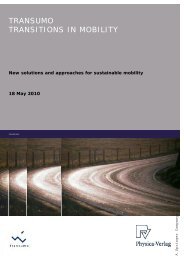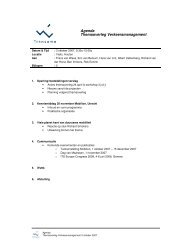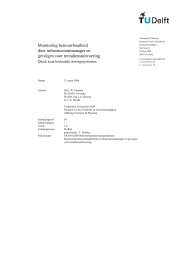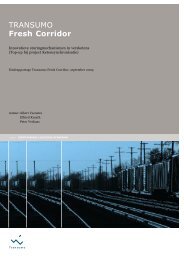Casestudie Breakdown prediction Contell PILOT - Transumo
Casestudie Breakdown prediction Contell PILOT - Transumo
Casestudie Breakdown prediction Contell PILOT - Transumo
You also want an ePaper? Increase the reach of your titles
YUMPU automatically turns print PDFs into web optimized ePapers that Google loves.
Moreover, the fridge’s filling level can vary the cooling-down time, so that form and<br />
shape of the corresponding temperature sequence changes, although the technical<br />
condition remains the same.<br />
Beside these general existing sources of error, the current practice is faced with<br />
additional problems that originate from the currently applied method, which was<br />
introduced in section 2.3.<br />
2.4.3 Methodological Problems<br />
The presented graphs within section 2.2 already exemplified many different<br />
behaviors of fridges and freezers. These examples were chosen to show the difficulty<br />
of an accurate classification of different kinds of behavior as normal operation or<br />
malfunction.<br />
The currently applied method to predefine critical temperature limits only allows a<br />
classification that is based on the actual temperature value. 9 Hence, as soon as<br />
temperature rises above the predefined maximum or falls below the predefined<br />
minimum, the cooling device is classified as malfunctioning. This method could<br />
indicate a bad technical condition of a fridge. But due to the lack of information and<br />
other possible error sources, it is impossible to prove a malfunction by using this<br />
method.<br />
Since an error of second kind has to be avoided in any case, H 0 has to be rejected<br />
every time, temperature limits are exceeded. This leads to a very high number of<br />
errors of first kind, because of the very low probability of a real technical<br />
malfunction. 10<br />
Beside this high number of false alarms, another methodological problem does exist.<br />
As mentioned in section 2.2.5, most malfunctions occur slightly, so that they could be<br />
recognized before temperature is exceeded. Such a change in form and shape of a<br />
temperature sequence is not recognized by the current method. Hence, situations<br />
like that lead to an error of second kind because H 0 is accepted, although the system<br />
starts to malfunction.<br />
Also the required recognition of changes in behavior on the long-run is only possible<br />
to some extent with the existing method. Typically, a change is bound to significant<br />
9 See section 2.3 for details<br />
10 See section 2.2.5 for details<br />
15
















